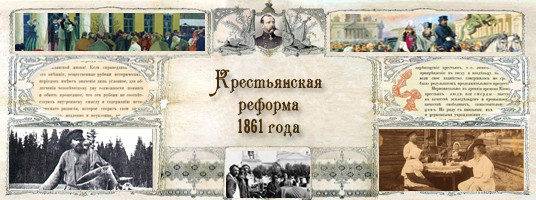Emancipation Reform of 1861

About the collection
In 2011, Russia celebrates the 150th anniversary of the abolition of serfdom. The collection, dedicated to this event, includes publications, covering the history of the peasant question in Russia, preparation and implementation of the peasant reform, the individual reformers, as well as key legislative instruments of reform, evidence of memoirs of contemporaries and journalistic essays on the peasant question.
The original list included about 250 documents, currently the access is open to more than 100 of them. It is planned to increase the total volume of the collection, and the number of copies of the digital public.
Brief History
February 19 (March 3, New Style) 1861, Emperor Alexander II signed the manifesto of the All-Merciful granting serf people of the status of free rural inhabitants and the overall situation of the peasants, emerged from serfdom, which consisted of seventeen acts. During March 1861 Manifesto, abolishing serfdom, was released throughout the Russian Empire. More than twenty million serfs were freed.
The peasant question was the key issue of Russia's domestic policy of late XVIII - early XIX century. One of the first attempts to legislative restrictions of serfdom was the Manifesto of three-day corvee, signed in 1797 by Emperor Paul I. Under Alexander I in 1803 was issued a decree on free cultivators, and in 1816-1819 serfdom was abolished in the Baltic provinces. In the reign of Nicholas I in 1837-1841 years was carried out reform of state peasants, and organized a series of secret committees Peasant Affairs. Although the measures were important steps towards the abolition of serfdom, one of the predecessors of Alexander II and was not able to completely solve this difficult problem.
Emperor Alexander II came to the throne in February 1855. At that time, the Russian Empire was in a state of deep domestic and foreign crisis. Society, shaken by defeat in the Crimean War of 1853-1856, demanded changes.
The abolition of serfdom was the first undertaking reform of Alexander II. January 3, 1857 has started to work the Secret Committee on Peasant Affairs, which in February 1858 was transformed into the Main Committee on Peasant Affairs. It submitted to the provincial committees. For its consideration of the provincial committees and the development of the overall reform of the project in March 1859, the project Editorial Committee was created with the Main Committee completed its work in October 1860. Materials of Editorial commissions, amounting to several tens of volumes, have been placed at the disposal of the Main Committee on Peasant Affairs. Discussion of the project of the reform, held in an atmosphere of heated debate, continued until January 1861. Finally, after a discussion of the draft Council of State Alexander II approved the final version of the reform.
Peasants’ release conditions are a compromise between the two main classes of Russian society - the peasantry and the nobility. The city received personal freedom and became owners of their house, farm buildings and personal property. However, the owners of the land were still landlords. Farmers received the status of the temporarily used by landlords and land on the mining conditions of serfdom or payment of dues. Under the terms of the reform, farmers could become owners of the land by buying it from their landlord.
Peasant reform has become the main business of the reign of Alexander II, received an honorary nickname Liberator. It cleared the way for further reforms - zemstvo, judicial, military and other reforms. In domestic historiography of 1860-1870s have been called the era of great reforms.
- Peasant question in Russia until the mid 19th century
- Abolition of serfdom

